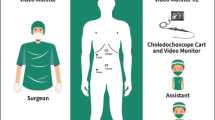Abstract
Background
Post-cholecystectomy bile leak is relatively a well-known surgical complication. Several potential treatment modalities for such leaks are used. The early use of ERCP to exclude significant bile duct injury and to treat the leak by various endoscopic means is supported by a large bulk of data. However, there is no consensus as to the optimal endoscopic intervention.
Methods
A retrospective review of ERCP database was done to identify all cases of bile leak related to cholecystectomy. Patient records including surgical and endoscopic reports were reviewed, and telephone interviews were conducted to collect data.
Results
During the period 2004–2016, 100 patients (53 men, 47 women; mean age, 55 years) with post-cholecystectomy bile leak were referred for ERCP. Cholecystectomy was done laparoscopically in 82 patients (with an open conversion rate of 13%). In the majority of cases (77%), the leak was diagnosed by ongoing bile flow from the drains. The most common symptoms were pain (17%) and fever (4%). The most common site of the leak was the cystic duct stump (79%) followed by subvesical ducts (7%). Low grade leaks were seen in 84% of cases. Treatment included stent insertion alone (9%), sphincterotomy alone (11%), combination stent/sphincterotomy (76%) and others (1%). Failed ERCP was encountered in 3%. Endoscopic therapy was successful in 90 patients (90%). In subgroup analysis, success rate of procedures with stent insertion (with or without sphincterotomy) is significantly higher compared to procedures without stent insertion (95.3% vs 72.7%, p < 0.05). The failure rate of sphincterotomy alone procedures (3/11, 27%) is much higher compared to procedures with stent insertion (4/85, 5%) with p < 0.05. Four patients (4%) developed post-ERCP pancreatitis (mild to moderate) and one patient (1%) suffered from retroperitoneal perforation.
Conclusion
The optimal endoscopic intervention for post-cholecystectomy bile leak should include temporary insertion of a biliary stent.

Similar content being viewed by others
References
Rustagi T, Aslanian HR (2014) Endoscopic management of biliary leaks after laparoscopic cholecystectomy. J Clin Gastroenterol 48(8):674–678
Barkun AN, Rezieg M, Mehta SN et al (1997) Postcholesytectomy biliary leaks in the laparoscopic era: risk factors, presentation, and management McGill Gallstone Treatment Group. Gastrointest Endosc 45:277–282
MacFadyen BV, Vecchio R, Ricardo AE et al (1998) Bile duct injury after laparoscopic cholecystectomy: the United States experience. Surg Endosc 12:315–321
Rerknimitr R, Sherman S, Fogel EL et al (2002) Biliary tract complications after orthotopic liver transplantation with choledochocholedochostomy anastomosis: endoscopic findings and results of therapy. Gastrointest Endosc 55:224–231
Bjorkman DJ, Carr-Locke DL, Lichtenstein DR et al (1995) Postsurgical bile leaks: endoscopic obliteration of the transpapillary pressure gradient is enough. Am J Gastroenterol 90:2128–2336
Sandha GS, Bourke MJ, Haber GB et al (2004) Endoscopic therapy for bile leak based on a new classification: results in 207 patients. Gastrointest Endosc. 60:567–574
Schnelldorfer T, Sarr MG, Adams DB (2012) What is the duct of Luschka? A systematic review. J Gastrointest Surg 16(3):656–662
Kaffes AJ, Hourigan L, De Luca N, Byth K, Williams SJ, Bourke MJ (2005) Impact of endoscopic intervention in 100 patients with suspected postcholecystectomy bile leak. Gastrointest Endosc 61(2):269–275
Cotton PB, Lehman G, Vennes J, Geenen JE, Russell RC, Meyers WC et al (1991) Endoscopic sphincterotomy complications and their management: an attempt at consensus. Gastrointest Endosc 37:383–393
Feliu Palá X, Encinas Méndez X, Poveda Gómez S, Martí SG (1996) Topical nitroglycerin: an alternative in the conservative treatment of biliary fistula. Rev Esp Enferm Dig 88(12):877–879
Brodsky JA, Marks JM, Malm JA, Bower A, Ponsky JL (2002) Sphincter of Oddi injection with botulinum toxin is as effective as endobiliary stent in resolving cystic duct leaks in a canine model. Gastrointest Endosc 56(6):849–851
Author information
Authors and Affiliations
Corresponding author
Ethics declarations
Conflict of interest
The authors Hoda Haidar, Elias Manasa, Kamel Yassin, Alain Suissa, Yoram Kluger and Iyad Khamaysi have no conflicts of interest or financial ties to disclose.
Additional information
Publisher's Note
Springer Nature remains neutral with regard to jurisdictional claims in published maps and institutional affiliations.
Rights and permissions
About this article
Cite this article
Haidar, H., Manasa, E., Yassin, K. et al. Endoscopic treatment of post-cholecystectomy bile leaks: a tertiary center experience. Surg Endosc 35, 1088–1092 (2021). https://doi.org/10.1007/s00464-020-07472-0
Received:
Accepted:
Published:
Issue Date:
DOI: https://doi.org/10.1007/s00464-020-07472-0




